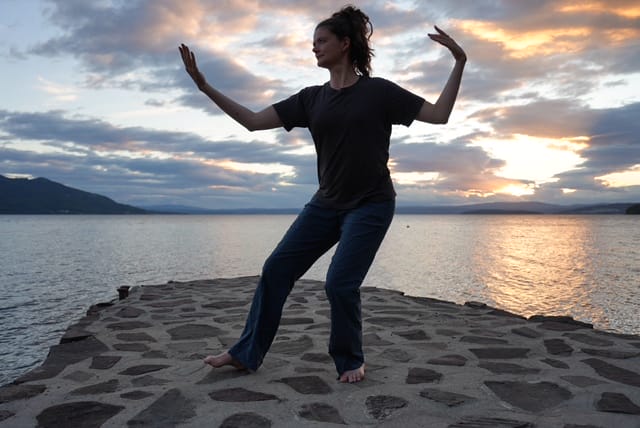Qigong is easy to learn and enjoyable to do

Even a few minutes of practise can have an invigorating and rejuvenating effect. Regular practice brings about a deep strengthening effect for the whole body and its various systems (nervous, digestive, respiratory, skeleton-muscular, hormonal, gynaecological, etc). Its ability to help in healing a large variety of chronic and acute injuries and illnesses has been the subject of various research programmes led by the Chinese medical authorities.
The aim of Qigong is to promote the movement of Qi (energy) in the body; this is done by opening certain gates and stretching and twisting energy channels. A key point in Qigong practice is relaxation and deep breathing, both of which are prerequisites to allow Qi to flow.
Qigong can be practised either as a discipline in its own right, or as a perfect complement to your Tai Chi training.
Some Qigong movements are very gentle, others more vigorous. Some movements are very large and expansive, others are more subtle, almost imperceptible. All are different and have a very specific effect on body and mind. The deeper one practises, the more one can understand the purpose of each movement, allowing the Qigong practice to become ever more enjoyable.
Feedback from past and current students shows that, with a little bit of regular practice, Qigong can have a powerful effect on mind, body and spirit. Reported benefits have included increased general health and well being, reduced levels of stress, and a brighter and more balanced outlook on life’s possibilities.
Qigong at Tai Chi Kitchen
At beginner level, we teach the following sets within Tai Chi Kitchen:

Baduanjin (Eight Pieces of Silk Brocade)
This is a set of eight simple exercises which has been practised unchanged throughout China for nearly 1000 years. Originally, it was used by the Chinese army to give strength and health in harsh adverse conditions. Nowadays, the set is performed to invigorate and strengthen the whole body including the internal organs.
Ershibashi (28-Step Qigong) (1st part)
This is a famous Qigong sequence whose soft and flowing movements are based on Tai Chi. Practising 28-Step Qigong helps to learn the Tai Chi form faster and beautifully complements it. Each simple movement has many particular health benefits.


Tai Chi Breaths
These are eight simple exercises which help to develop awareness of the body and feeling of Qi.
Elemental Breaths
These are fundamental visualisations and breathing exercises which help to purify the mind and heart. They help to release anxiety and transform negative emotions into positive ones.


Zhan Zhuang
This is a sequence of standing meditation postures, which is fundamental to the practice of Qigong and Tai Chi. Practised regularly, Zhan Zhuang postures help to develop concentration and mental and physical strength. They are the basis of developing internal energy.